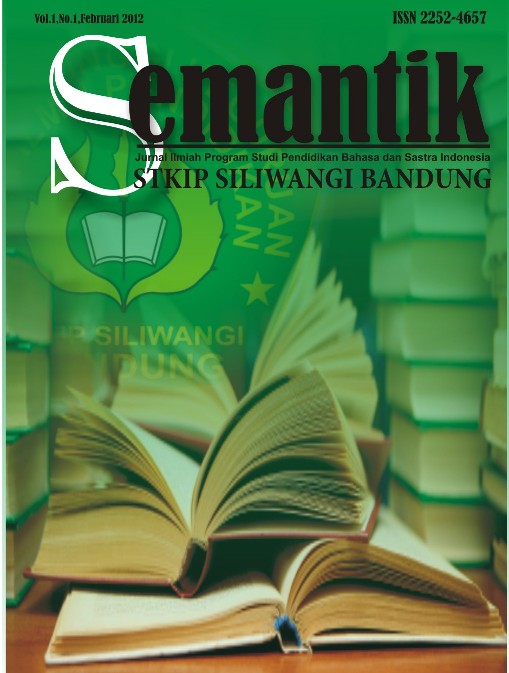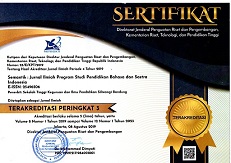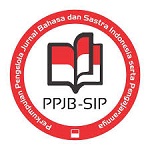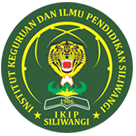PENGACUAN DALAM WACANA TULIS DI FACEBOOK
DOI:
https://doi.org/10.22460/semantik.v1i1.p%25pKeywords:
facebook, discourse analysis, reference type, form referenceAbstract
This research includes qualitative research on the types of written discourse on facebook regarding the use of marker variation reference cohesion. The method used is the method intended by agih Sudaryanto (1993: 15), to analyze and interpret text using the theory of discourse analysis as Teun van Dijk microstruktur basis at the level of reference. Techniques of data analysis techniques used in the form disappeared, engineering change, read markup techniques. From the results of discourse analysis in the type and form reference bookmarks. Reference marker types based on where it comes endofora reference, while according to the type includes (1) reference first persona, a persona the second, and third person, (2) reference demonstrative public bookmarks, bookmark the pronouns, pronouns bookmark affairs, and the clock, and ( 3) reference comparative ekuatif level, the level of comparative, and superlative level. Being reference marker contained in the written discourse found in the facebook include saya, aku, -ku, gue, kita, kamu, anda, kau-, -mu, sampean, ente, you, antum, dia, -nya, mereka, ini, itu, sini, situ, begini, begitu, saat ini, hari ini, kaya, macam, seperti, lebih…, kurang…., paling, dan semakin.References
A. Hamid Hasan Lubis. 1991. Analisis Wacana Pragmatik. Bandung: Angkasa.
Abdul Syukur Ibrahim (edt). 2009. Metode Analisis Teks dan Wacana. Yogyakarta: Pustaka Pelajar.
Adjat Sakri. 1992. Bangun Paragraf Bahasa Indonesia. Bandung: Penerbit ITB.
Bambang Hartono. 2000. Kajian Wacana Bahasa Indonesia. Diktat Perkuliahan. Universitas Negeri Semarang.
Brown and Yule. 1996. Discourse Analysis. Penerjemah I. Soetikno. Jakarta: Gramedia.
Hasan Alwi. 1998. Tata Bahasa Baku Bahasa Indonesia Edisi 3. Jakarta: Balai Pustaka.
Jorgensen, Marianne W. 2007. Analisis Wacana Teori dan Metode. Yogyakarta: Pustaka Pelajar.
M. Ramlan. 1993. Paragraf Alur Pikiran dan Kepaduannya dalam Bahasa Indonesia. Yogyakarta: Andi Offset.
Nunan, David.1992. Mengembangkan Pemahaman Wacana: Teori dan Praktik. Terjemahan Elly, W. Silangen. Jakarta: Rebia Indah Pustaka.
Praptomo Baryadi. 2002. Dasar-dasar Analisis Wacana dalam Ilmu Bahasa. Yogyakarta: Pustaka Gondhosuli.
Poerwadarminta, W. J. S. 1976. Kamus Umum Bahasa Indonesia. Jakarta: PN Balai Pustaka.
Sarwiji Suwandi. 2009. Serba Linguistik. Surakarta: Sebelas Maret University Pres.
Sumarlam edt. 2003. Teori dan Praktik Analisis Wacana. Surakarta: Pustaka Cakra.
Sumarlam edt. 2008. Analiss Wacana Iklan Lagu Puisi Cerpen Novel Drama. Bandung: Pakar Raya.
Sumadi, dkk. 2009. Kohesi dan Koherensi dalam Wacana Naratif Bahasa Jawa.Jakarta: Departemen Pendidikan dan Kebudayaan.
Sudaryanto. 1993. Metode dan Aneka Teknik Analisis Bahasa Pengantar Penelitian Wahana Kebudayaan Secara Linguistik. Yogyakarta: Duta Wacana University Press.
Tarigan, Henry Guntur. 1987. Pengajaran Wacana. Bandung: Angkasa.
Titscher, Stefen. 2009. Methods of Text and Discourse Analysis. Terjemahan. Yogyakarta: Pustaka Pelajar












